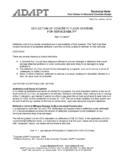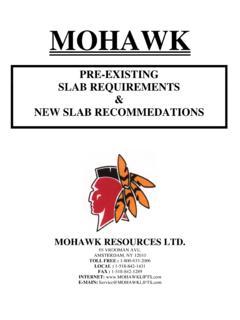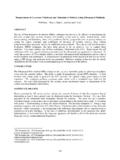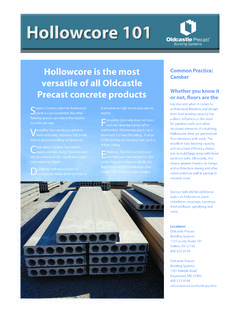Transcription of The Floor Flatness Report
1 This article is a continuation of the What's This Report For? series, based on a technical session sponsored by ACI Committee E702, Designing concrete Structures. In keeping with ACI's mission to provide knowledge and information for the best use of concrete , the articles will be posted on the ACI Web site ( ) and, along with sample reports and multiple-choice questions, be used for educational materials. The Floor Flatness Report What the designer needs to know by Mark A. Cheek F loor profile finish quality has traditionally been specified by limiting the gap under either an unleveled or leveled 10 ft (3 m) straightedge. Some specifications system,1 provides a welcome alternative and a solution to the generally recognized inadequacies of the 10 ft (3 m).
2 Straightedge to describe and define Floor profiles. still take this tolerance approach, even though there Floor Flatness (FF) and levelness (FL) numbers is no nationally accepted standard either for taking determine whether a Floor is sufficiently smooth and measurements or for establishing compliance of a Floor level, respectively, as constructed. Floor Flatness can profile. In many specifications, slab finish quality is not affect flooring installation, ride quality and safety in addressed at all. Use of a nonstandard test procedure and warehouses, and drainage. Floor levelness can affect failure to specify Floor profiles often lead to conflict and shelf placement and design and a slab's drainage plan. litigation.
3 For example, if the project specification calls For example, the levelness of the Floor in a warehouse for a 10 ft (3 m) straightedge to determine the quality of could limit how high pallets of goods can be safely the finished Floor and the test area is 100 x 100 ft (30 x stacked. Typical FF and FL values for different applications 30 m), a technician can place the 10 ft (3 m) straightedge are shown in Table 1 and Fig. 1. at a single location and measure the gaps between it and the Floor . Operating without a standard, the technician Appropriate Flatness and levelness could simply use the measurement from that one location As in any other specification, the engineer should as representative of the entire test area.
4 It may (by determine what is good enough for the application rather some chance) be representative of the whole Floor than impose a standard that is unnecessarily exacting but most likely is not; thus, the results obtained are and costly. Both overall Flatness and levelness numbers essentially useless. should be specified, along with the local minimum values (typically 60% of the overall numbers). The test should Profiling Standard be conducted within 72 hours of finishing the slab, as the The technology for measuring Floor profiles has curing process could cause the slab to curl and deviate developed in response to the need for a standard method from the Flatness achieved by the finishers. Obtaining to evaluate them.
5 This technology, called the F-number these numbers within 72 hours also allows the contractor concrete international / January 2011 35. to make adjustments to the procedures, if necessary, while ASTM E1155, Standard Test Method for Determining the Floor is still being placed. Both Flatness and levelness FF Floor Flatness and FL Floor Levelness Numbers, is a numbers can be determined on shored decks, but only quantitative method of measuring Floor surface profiles to Flatness numbers can be determined on unshored decks. obtain estimates of the Floor 's characteristic FF and FL. numbers. Each slab requires a number of individual Measurement sample measurement lines (test runs). The quantity of The FF number is an indication of how bumpy or wavy test runs is determined by the area to be tested.
6 The the slab surface is, demonstrating the quality of the initial greater the area, the more test runs are required; thus, strike off and finishing process. The F-number system more data are accumulated and processed to determine uses Floor surface curvature calculated from elevation F-number values for the slab. differences over 24 in. (600 mm) increments as a measure In accordance with ASTM E1155, the test area must be of Flatness (Fig. 2). The FL number is an indication of how organized into a test surface, test section(s), and test level the slab is, demonstrating how level the forms were runs (Fig. 4). After the number and length of test runs are set. The Floor slope is measured over a distance of 10 ft determined, the test runs can be laid out and the run (30 m) (Fig.)
7 3). path swept clean. Once the test runs are laid out and Table 1: Typical Flatness (FF ) and levelness (FL) numbers for various applications (ACI )2. Composite Flatness , FF Composite levelness, FL Typical applications Noncritical: mechanical rooms, nonpublic areas, 20 15. surfaces to have thick-set tile, parking structure slabs Carpeted areas of commercial office buildings or 25 20. lightly-trafficked office/industrial buildings Thin-set flooring or warehouse Floor with moderate or 35 25. heavy traffic 45 35 Warehouse with air-pallet use, ice, or roller rinks >50 >50 Movie or television studios Fig. 2: The Flatness is calculated from elevation readings over 24 in. (600 mm) increments Fig. 1: Typical Flatness and levelness requirements for various Fig.
8 3: The Floor levelness is calculated from elevation readings applications2 over 10 ft (3 m) increments 36 January 2011 / concrete international cleaned, data can be collect using a Dipstick Floor profiler (Fig. 5) or equivalent. Minimum sampling requirements are discussed in ACI Reviewing the Report A typical Report includes a description of the test surface, test section(s) and location of test runs, the overall FF and FL numbers for the slab, the individual FF and FL numbers for each test run, and whether any required local minimum was violated. A graph of each test run may be included. The graph (Fig. 6) shows the change in elevation versus distance for the surface. When reviewing a Report , you should first verify that the overall FF and FL values meet the specified requirements.
9 For example, suppose your project specification calls for a minimum FF of 25 and a minimum FL of 20. The correspond- ing minimum local values are typically 60% of these values, or and , respectively; these should be spelled out in the specification. Looking at the example data in Table 2, you can see that the overall Flatness and levelness requirements have been met. Fig. 4: Sample layout for After checking the overall Flatness and levelness values Flatness and levelness against the specification, check the values of FF and FL for measurement of a Floor concrete international / January 2011 37. the individual test runs. Figure 6 shows an example test The last step is to check to see whether any local run. The vertical scale is exaggerated to show the profile minimum values have been violated.
10 Reviewing the data more clearly. In this case, FF = , higher than the in Table 2, you can see that Test Run 2EW violates the overall requirement and higher than the required local minimum local value of FL because it is only , less minimum of , and FL = , lower than the overall than the minimum local value All other test runs requirement but higher than the required local minimum meet the minimum local values for both FF and FL. of Remedies If the overall FF and FL values exceed the minimum specified requirements and the minimum local values have not been violated, there is no need for remediation. However, if as in the example the overall values meet the specification and the minimum local values don't, the surface will need remediation in the areas where the minimum local values were out of spec.





